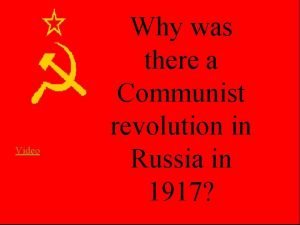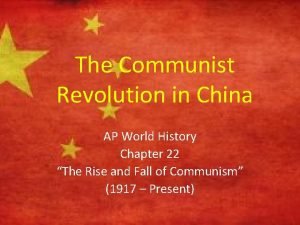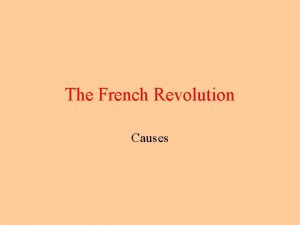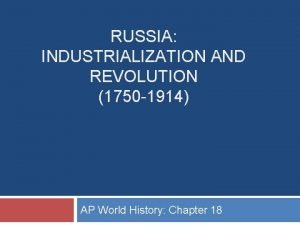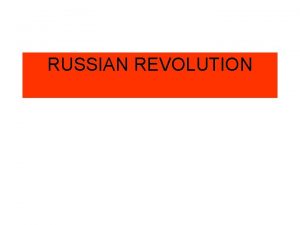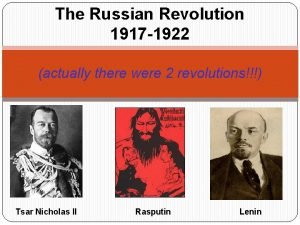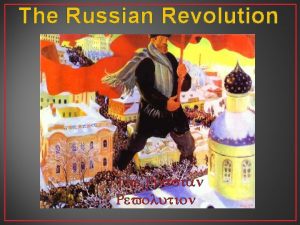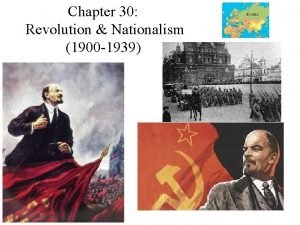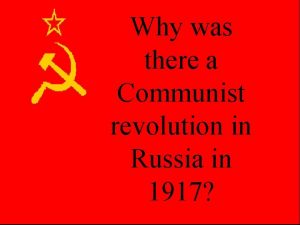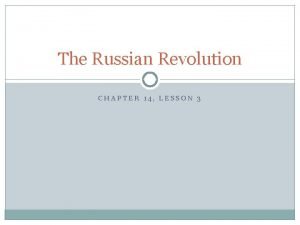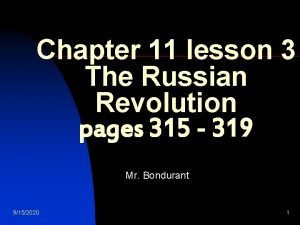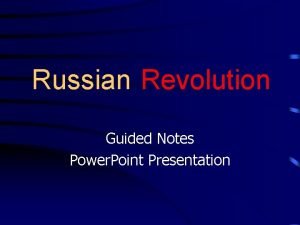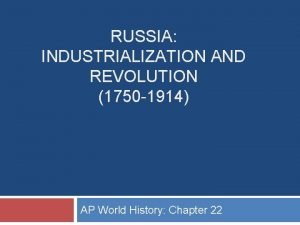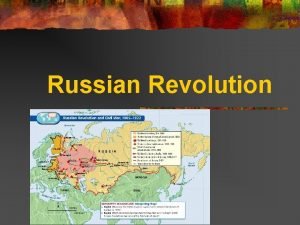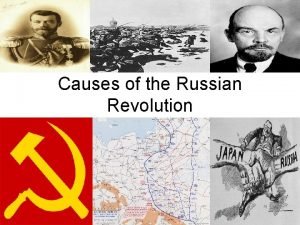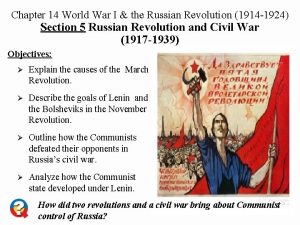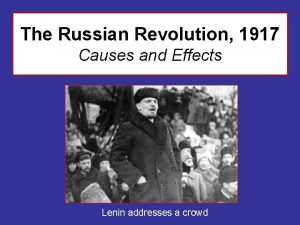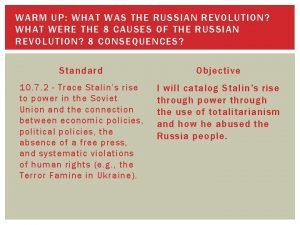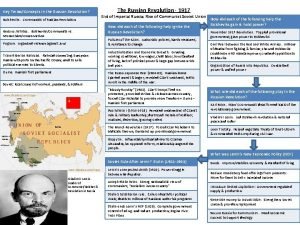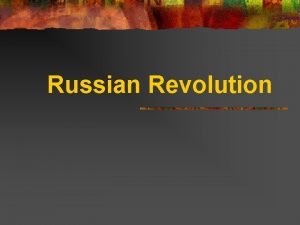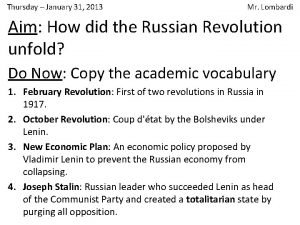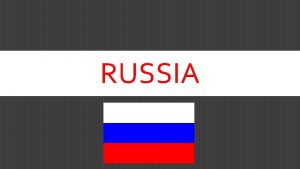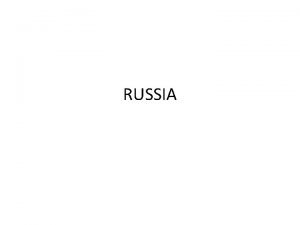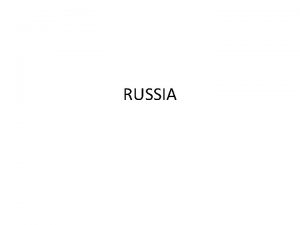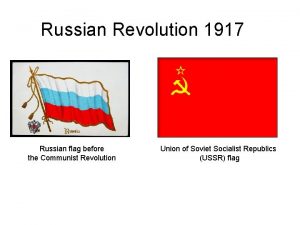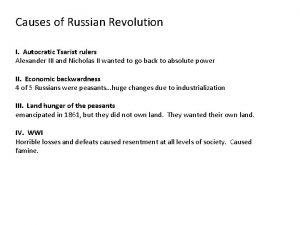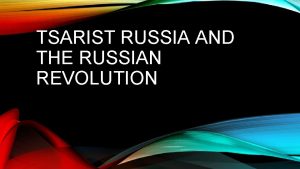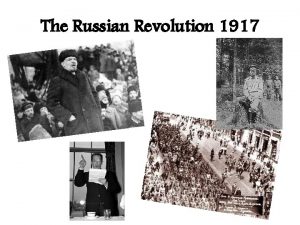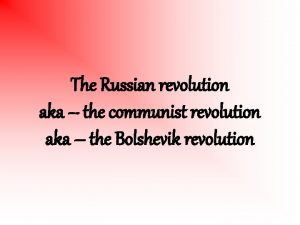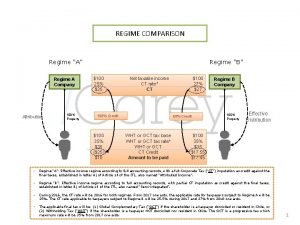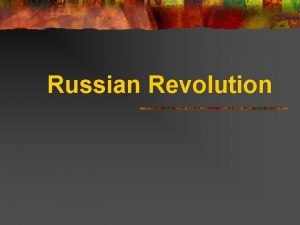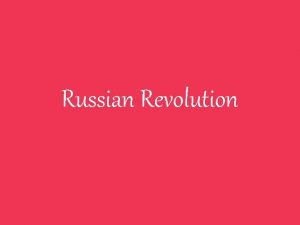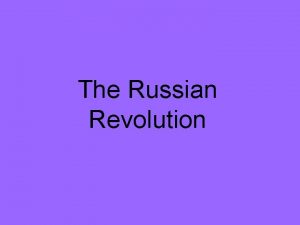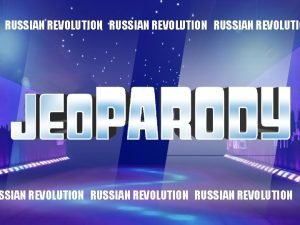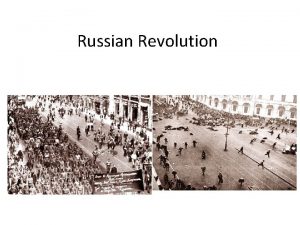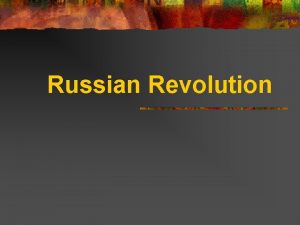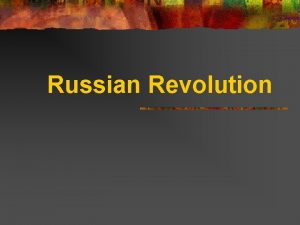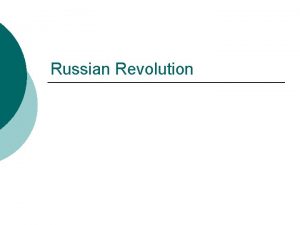The Russian Revolution From Tsarist Regime to Communist

























- Slides: 25

The Russian Revolution From Tsarist Regime to Communist Dictatorship

OVERVIEW In these lessons, you will examine: • Social and political factors causing change • Causes and effects of the March and November Revolutions of 1917 • Factors leading to the Red Army’s victory in the Civil War • Leninism • The Rise of Stalin and the creation of the totalitarian state

Key Factors towards overthrow • • Russian defeat in the Russo-Japanese War (1904 -1905) “Bloody Sunday” (Jan 22, 1905) The continuation of Rasputin’s influence over the Romanov court The failure of the Tsar’s leadership in the Great War

Prior attempts at Change • • October Manifesto (Oct 30, 1905): As a result of the great unpopularity of his regime after “Bloody Sunday”, Tsar Nicholas II allowed Sergei Witte to design guarantees for civil liberties, including the creation of a parliament, the Duma October 1906 – Land reform designed by Peter Stolypin allowed peasants greater opportunities to own land

The Effects of World War I • Loss of territory to German forces after a series of defeats • Low morale and mass desertions in the army • Drop in agricultural production and lack of food in the cities • Rapid and acute inflation

Key Features of the March Revolution • Not organized – evolved from mass protests in St. Petersburg and other cities • Not representative – the Duma, which consisted mainly of elites, formed a provisional government • Fragile – support for the newly created Provisional Government depended on agreement by the Petrograd Soviet

Kerensky’s Failures Kerensky believed that the people would be motivated to fight for the possibility of a democratic government Soldiers continued to desert the battlefield – the possibility of democracy was not enough

Kerensky’s Failures The people demanded: An end to the war Land reform Economic recovery Lenin promised: Peace Land Bread

The Turning Point • General Kornilov planned to march his army on the Provisional Government • Kerensky needed the Bolsheviks and the Petrograd Soviet to stop Kornilov • The victory over Kornilov gave legitimacy to Lenin and the Bolsheviks • Lenin seized power in a bloodless coup on Nov 6 -8

“Peace, Land Bread” Unlike the Provisional Government, Lenin’s regime attempted to act quickly on its promises Bread Peace The Treaty of Brest. Litovsk resulted in peace at the cost of major territories Land Lenin granted the peasants control of the land The Civil War would interrupt long-term economic planning – Lenin enacted “War Communism”

Girding Towards Civil War From 1917 to 1918, Lenin began the foundations for non-democratic, one-party rule, which drew increasing opposition • The Constituent Assembly was shut down after the Bolsheviks lost the elections in Jan 1918 • The Cheka secret police was created to hunt down and assassinate “counterrevolutionaries”

The Civil War: Who were the Whites? With the increasing consolidation of the CCP’s control, forces rose against the “Reds”. The Whites were composed of various forces: • Tsarists – military leaders who returned from the frontlines wanted to restore the monarchy • Liberals – political leaders and moderate elites who wanted a parliamentary democracy or republic • Former POW’s – the “Czech Legion” was composed of mainly Czech soldiers who were captured during the Great War and wanted to return home.

Western Intervention The Whites were supported by Britain, France and the US in different ways: • Western forces engaged the Red Army and occupied Russian ports • Western forces supplied weapons and funding to the White armies • Western forces isolated the Reds economically and diplomatically

Factors towards the Red victory • Controlled the industrial centers • Controlled the railway (could rush troops and supplies to fronts) • Superior morale and determination • Leon Trotsky’s leadership

Leninism The challenges of Russian society, politics and economics forced Lenin to adapt a new approach to the application of socialism to Russia: Politics Economics Russia had no tradition of democracy and its populace was largely uneducated and illiterate Russia’s economy was devastated, and major industry was basically non-existent; most capital had fled the country

“War Communism” vs. “NEP” During the war, Lenin felt it necessary to take control over the economy to help ensure the Red victory. Features of this policy stated that: • All surplus crops were to be given to the Red Army • All large firms would be nationalized by the state • Workers were moved involuntarily to wherever they were needed These policies continued even after the Civil War while facing increasing opposition

Lenin’s “New Economic Policy” In response to the rebellion at Kronstadt, calls within the party for economic moderation and an end to the harsh conditions of “War Communism” Lenin responded with his “NEP”: • Restoration of private trade and ownership • Peasants could sell surplus crops at markets

The struggle for power Stalin Lenin’s death in. Josef 1924 and the lack of a clear educated leader to follow • Poorly resulted in a power struggle: • Relatively unknown in the Civil War; held the position of General Secretary • Advocate for “Socialism in One Country” Leon Trotsky • Educated and intelligent • Hero of the Civil War • Advocate for “International Socialism”

Stalinist Economics • • • With communist parties marginalized in Western countries, Stalin looked to the development of the Soviet Union itself. His first, “Five-Year Plan” focused on: Development of heavy industries: coal, iron, steel and oil Forced collectivization Exaggerated goals Strict punishment for failure Limited rewards for success

Collectivization • Land ownership was prohibited and farmers were forced to move into collective farms (“kolkhoz”) • Those who resisted were labeled as “kulaks” (wealthy peasants) and were persecuted with the support of the peasantry • Collectives were modernized with machinery; all output from collective farms was sold to the state at a fixed price

Stalinist Politics • Stalin consolidated his power through the use of “show trials” and the development of the “gulag” system; all major political opponents had been put into jail, assassinated or forced out of the USSR by 1929 • The army was purged as many army officers were executed, including heroes from the civil war • Political dissent within the party was not permitted; major decisions required Stalin’s approval and Pravda, the official party newspaper was the only voice

Any of the original members of the Central Committee of the Communist Party during the November Revolution who did not die of natural causes or other reasons were killed by Stalin’s agents.

All traces of political opponents were erased from history as Stalin’s forces doctored photographs and documents to match his vision. Images of Stalin together with Lenin were increasingly produced by his propaganda machine.

The Cult of Stalin By the mid-1930’s Stalin had established himself economically and politically as the true follower of Lenin’s legacy: • Economically, Russia was matching the West and would not be affected by the Great Depression • Politically, Stalin had no viable opposition and carefully controlled propaganda helped to maintain a “personality cult”

Summary Questions • What were the major factors which allowed a 300 year-old tsarist dynasty to collapse? • What effect did Western involvement have on the Russian Civil War? • In what ways did the Communists adapt their ideology to the realities of their politics, economics and society? • What processes allowed Stalin to establish and maintain one-man rule over the nation when others had failed?
 Russian revolution vs french revolution
Russian revolution vs french revolution Chinese communist revolution ap world history
Chinese communist revolution ap world history Communist revolution
Communist revolution Chinese communist revolution ap world history
Chinese communist revolution ap world history What are the main causes of french revolution
What are the main causes of french revolution Russian revolution of 1905 definition ap world history
Russian revolution of 1905 definition ap world history Russian revolution
Russian revolution Russia after ww1
Russia after ww1 In the view of this cartoonist russia under
In the view of this cartoonist russia under Chapter 30 revolution and nationalism worksheet answers
Chapter 30 revolution and nationalism worksheet answers Introduction of russian revolution
Introduction of russian revolution Lesson 3 the russian revolution
Lesson 3 the russian revolution The russian revolution
The russian revolution Russian revolution guided notes
Russian revolution guided notes Russian revolution of 1905 definition ap world history
Russian revolution of 1905 definition ap world history The russian revolution
The russian revolution Causes and effects of the russian revolution
Causes and effects of the russian revolution Chapter 14 world war 1 and the russian revolution
Chapter 14 world war 1 and the russian revolution Causes and effects of the russian revolution
Causes and effects of the russian revolution Russian revolution causes and effects
Russian revolution causes and effects Triple alliance ap euro
Triple alliance ap euro Political cartoon russia
Political cartoon russia Russian revolution
Russian revolution Http://www.history.com/topics/russian-revolution
Http://www.history.com/topics/russian-revolution Czar in russian revolution
Czar in russian revolution Causes of the russian revolution
Causes of the russian revolution


